The Lynnfield Preview: Rumblings of Revenge
by Anand Lal Shimpi on May 29, 2009 1:00 PM EST- Posted in
- CPUs
SYSMark 2007 Performance
Our journey starts with SYSMark 2007, the only all-encompassing performance suite in our review today. The idea here is simple: one benchmark to indicate the overall performance of your machine.
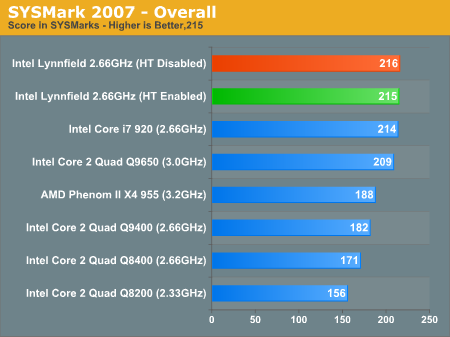
Ok. Right out of the gate, on pre-production silicon, with a pre-production motherboard and without a super aggressive turbo-mode the 2.66GHz Lynnfield sample is able to perform just as well as the i7-920. This is just as we expected given the minimal impact of triple-channel DDR3 on i7 that we pointed out in our original review.
Curiously enough, HT doesn't seem to do anything at all for Lynnfield in this test. Remember that stressing four cores is tough enough, finding eight CPU intensive threads is even more difficult.
Adobe Photoshop CS4 Performance
To measure performance under Photoshop CS4 we turn to the Retouch Artists’ Speed Test. The test does basic photo editing; there are a couple of color space conversions, many layer creations, color curve adjustment, image and canvas size adjustment, unsharp mask, and finally a gaussian blur performed on the entire image.
The whole process is timed and thanks to the use of Intel's X25-M SSD as our test bed hard drive, performance is far more predictable than back when we used to test on mechanical disks.
Time is reported in seconds and the lower numbers mean better performance. The test is multithreaded and can hit all four cores in a quad-core machine.
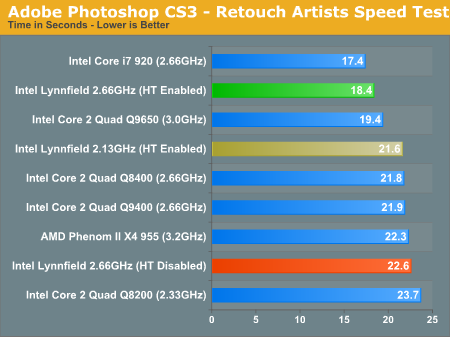
DivX 8.5.3 with Xmpeg 5.0.3
Our DivX test is the same DivX / XMpeg 5.03 test we've run for the past few years now, the 1080p source file is encoded using the unconstrained DivX profile, quality/performance is set balanced at 5 and enhanced multithreading is enabled:
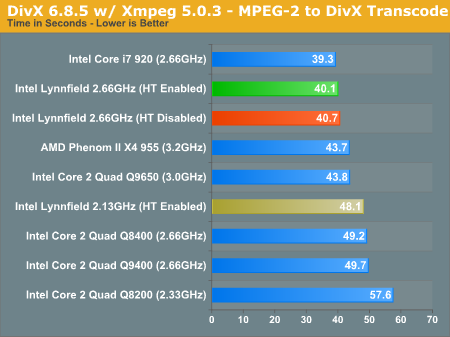
Once more, we see very little impact from Hyper Threading; the entry level Lynnfield may not be as bad as you'd think. On top of that, the crippled Lynnfield is less than 4% slower than the Core i7-920. Enable its aggressive turbo mode and I believe we'll have a chip that can actually beat, even if only slightly, the Core i7-920.
x264 HD Video Encoding Performance
Graysky's x264 HD test uses the publicly available x264 codec (open source alternative to H.264) to encode a 4Mbps 720p MPEG-2 source. The focus here is on quality rather than speed, thus the benchmark uses a 2-pass encode and reports the average frame rate in each pass.

The x264 encode test shows one application where Hyper Threading is important. A 2.13GHz Lynnfield with HT enabled is faster than a 2.66GHz Lynnfield with HT disabled, unfortunately the former isn't on the roadmap and the latter is what we're getting.
Without HT enabled the $196 Lynnfield 2.66GHz core is faster than every non-EE Penryn Core 2 Quad as well as AMD's Phenom II X4 955 (in the second pass of the test). The i7-920 is significantly faster thanks to having HT enabled; and now we have the perfect reason for Intel disabling HT on the "low end" Lynnfield.
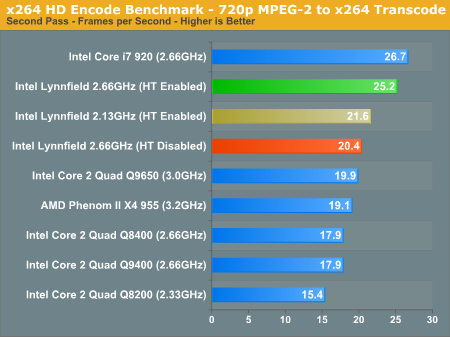
Windows Media Encoder 9 x64 Advanced Profile
In order to be codec agnostic we've got a Windows Media Encoder benchmark looking at the same sort of thing we've been doing in the DivX and x264 tests, but using WME instead.
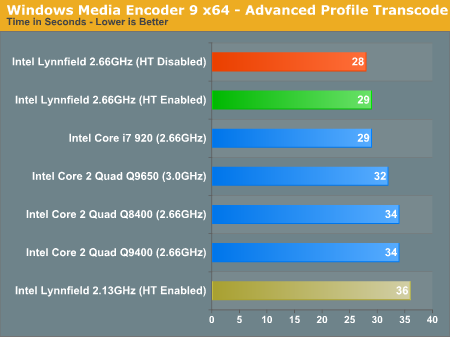
Tests that don't scale well with HT enabled, once again, show no performance difference between a 2.66GHz Lynnfield and a 2.66GHz Bloomfield.










95 Comments
View All Comments
Anand Lal Shimpi - Saturday, May 30, 2009 - link
P55 essentially has the same ICH feature set as P45. You get support for six SATA 3.0Gb/s ports, 12 USB 2.0 and PCIe 2.0.Intel's chipsets are actually what I use for all of my SSD tests and they work quite well. I wouldn't expect any different out of P55.
Remember that P55 is only the first Lynnfield chipsets, next year we'll see more. This chart speculates on some of the features of those (it also lists 14 USB instead of 12, I'm not sure which one is right):
http://img405.imageshack.us/img405/74/hkepcibexpea...">http://img405.imageshack.us/img405/74/hkepcibexpea...
Take care,
Anand
Drazick - Saturday, May 30, 2009 - link
I thought so...I hope someone will adopt the changes quickly.
It's about time to get rid of the BIOS and make room for speed improvements int the Flash chips (Both via the SATA 3 and USB 3).
Do you see in the horizon how long will it take before will see those features?
Thank you for the response.
Krogoth255 - Saturday, May 30, 2009 - link
I find it very funny when people make a huge fuss over a 2-10% difference in performance (i5 versus i7). It is sad that even budget CPUs are bloody overkill for majority of computer users.The bottom line is that i5 is going to be Intel's next big winner. It is the perfect Phenom II killer and an excellent successor to the Core 2 parts that it is replacing. I7 makes very little sense unless time is $$$$$.
PrinceGaz - Sunday, May 31, 2009 - link
Exactly. My nearly four-year old S939 Athlon 64 X2 still performs everything I do (with one exception) more than fast enough so the difference between the i5 and i7 would be irrelevant. I still think I'm at least a year or two from doing a new build (the only thing of any value at all in my current box I could reuse would be the graphics-card, a 640MB 8800GTS; most of the drives are parallel ATA, and the memory is of course DDR).Given that the one app where my current rig struggles is PCSX2 (a Playstation 2 emulator), it seems kind of silly to spend upwards of £500 for a new box simply to play PS2 console games, when I could probably buy a new PS2 console for under £100. Therefore debates over the relative merits of i5 and i7 which are both much faster are rather moot for me at the moment, and the vast majority of the PC buying public. It is nice to know how they compare though, and what their pros and cons are (the main con I see being the price of X58 mobos), so I'm thankful for this informative article on AT.
just4U - Saturday, May 30, 2009 - link
I don't quite understand why X58 boards are so expensive. At first we were complaining about ddr3 prices.. but they've come down to a managable point. While cheaper X58 solutions are starting to crop up it's still extremely high and I don't quite get why that is.With the memory controller integrated into the chip you'd think that the cost of the boards would be cheaper overall. That was one of Amd's main selling points (if I remember right) but for the i7 not the case.. the boards are priced incredibly high.
Anand Lal Shimpi - Saturday, May 30, 2009 - link
It's artificial. The boards are priced so high because Intel charges quite a bit of money for the X58 chipset. It's the cost of competition; if AMD had a true answer to i7 we'd have much more affordable i7 platforms all of the sudden :)Take care,
Anand
jmurbank - Sunday, May 31, 2009 - link
Chipset and processor prices are two different things. Neither are related to each other. Like all products, prices of chipsets is related to other chipsets competing at the same level. Since the X58 does not have any competitor, people have to pay a high premium for a complete i7 system. If nVidia is allowed to make a chipset for the i7 processor, we will see these high premium prices decrease. Since the i7 processor is designated as enthusiast setup, prices will still be at enthusiast pricing.just4U - Saturday, May 30, 2009 - link
You've had them on your test beds so you'd know better then I. Hell I haven't even gotten any hands on with the i7 since people here keep opting for the PII. Not that that's a bad thing, I am rather impressed with those overall just..Im beginning to realize the only way Im going to get my grubby little paws on a I7 is if I go out and build it for myself. Even I balk a little bit at the price tag of some of those boards but there are a few coming down the pipeline that look a little bit more reasonably priced.
Jabbernyx - Saturday, May 30, 2009 - link
EX58-UD3R = $150 from eWiz ;)goinginstyle - Saturday, May 30, 2009 - link
It is $185.99 at eWiz with a $15 rebate that will take two months to get for an end price of $170.99.